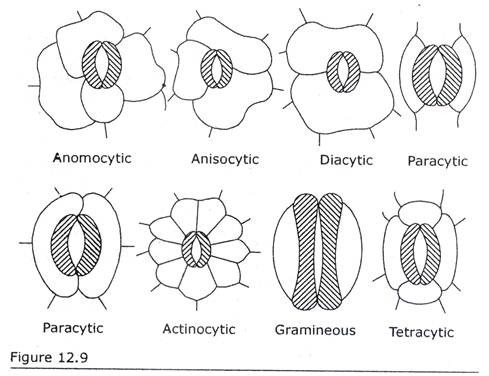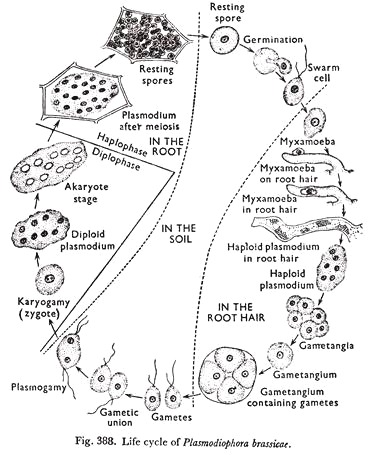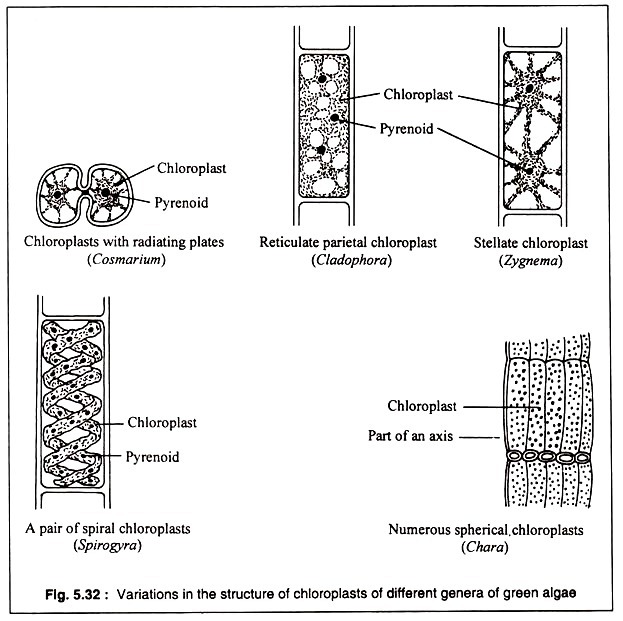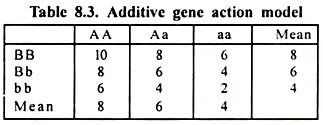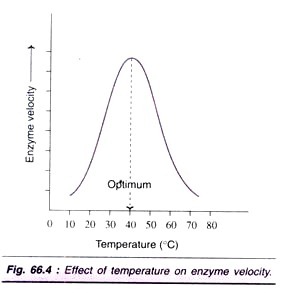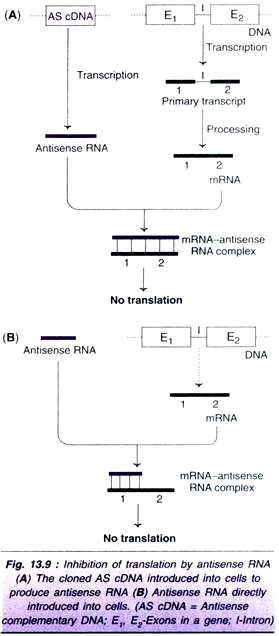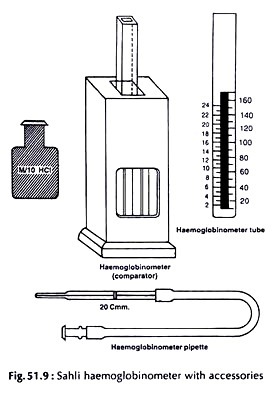ADVERTISEMENTS:
Read this article to learn about the Ecosystem:- Read this article to learn about:- 1. Definition of Ecosystem 2. Classification of Ecosystem 3. Components of Ecosystem 4. Structure of an Ecosystem 5. Functions 6. Types.
Definition of Ecosystem:
The term Ecology (Greek Oikos-house, logos-study) was coined by German biologist Ernst Haeckel in 1869.
Ecology deals with the study of interactions between living organisms and their physical environment.
ADVERTISEMENTS:
Now ecology is defined as the study of ecosystems. The term ecosystem was proposed by A.C. Tansley in 1935 where eco implies the environment and system denotes an interacting, interdependent, integrated complex.
Ecosystem may be defined as the system resulting from the integration of all living and non-living factors of the environment. Thus any structural and functional unit of biosphere where the organisms interact with the physical environment so that a flow of energy leads to clearly defined trophic structure, biotic diversity and material cycle (i.e., exchange of materials between living and non-living components) within the system is known as an ecological system or ecosystem.
Earth is a giant ecosystem where abiotic and biotic components are constantly acting and reacting with each other bringing structural and functional changes in it. This vast ecosystem-biosphere is subdivided into units of smaller ecosystems such as terrestrial and aquatic ecosystems.
These systems may be freely exchanging energy and matter from outside—an open ecosystem or may be isolated from outside—a closed ecosystem.
ADVERTISEMENTS:
An ecosystem is normally an open system with a continuous but variable influx and loss of material and energy. It is a basic, functional unit with no limits of boundaries.
Thus an ecosystem represents the highest level of ecological integration which is energy based and this functional unit is capable of energy transformation, accumulation and circulation. Its main function in ecological sense is to emphasize obligatory relationships, interdependence and casual relations.
Classification of Ecosystems
1. Natural Ecosystems (Self-operating):
These systems operate by themselves under natural conditions without any major interference by man.
These are further divided into following ecosystems:
(i) Terrestrial ecosystem includes forests, grasslands and deserts etc.
(ii) Aquatic ecosystem may be further distinguished as
(a) Fresh water which may be lotic (running water as springs, streams or rivers) or lentic (standing water as lakes, ponds, pools, ditches, puddles, swamps etc.).
(b) Marine water such as oceans (deep bodies) or seas or estuaries (shallow ones).
2. Artificial (Man-engineered) Ecosystems:
These are maintained artificially by man where, by addition of energy and planned manipulations, natural balance is disturbed regularly. Crop, urban, industrial, space and control of biotic community as well as the physico-chemical environment are man-engineered ecosystems.
ADVERTISEMENTS:
3. Space Ecosystem is also recognised as one of ecosystems and play a very important role in human life.
The common features of all ecosystems — terrestrial, aquatic and agricultural are the interactions of the autotrophic and heterotrophic components.
Components of Ecosystem:
An ecosystem has two major components—biotic and abiotic.
(A) Biotic (Living) Components:
Plants, animals and micro-organisms having different nutritional behaviour constitute the biotic components of an ecosystem.
ADVERTISEMENTS:
1. Producers (or Autotrophs-Self nourishing):
Producers are mainly chlorophyll bearing green plants (photo autotrophs) which can synthesize their food in presence of sunlight making use of CO2 and water through the process of photosynthesis. Since plants convert solar energy into chemical energy so they must be better called converters or transducers. Chemosynthetic organisms or chemo-autotrophs can also synthesize some organic matter by the oxidation of certain chemicals in absence of sunlight.
2. Consumers (or Heterotrophs or Phagotrophs):
Consumers consume the matter built up by the producers. They utilise, rearrange and decompose complex materials.
ADVERTISEMENTS:
[Note: The major autotrophic metabolism occurs in the upper green belt stratum where solar energy is available while the intense heterotrophic metabolism occurs in the lower brown belt where organic matter accumulates in soil and sediments.]
Consumers are of the following types:
(i) Herbivores:
They feed directly on producers and hence are known as primary consumers, e.g., rabbit, deer, cattle, insects etc. Elton (1927) called herbivores as key industry animals because they convert plants into animal materials.
ADVERTISEMENTS:
(ii) Carnivores (Meat eaters):
They feed on other consumers. If they feed on herbivores, they are called secondary consumers (e.g., frog, birds, cat) and if they prey on other carnivores (snake, peacock), they are known as tertiary carnivores/consumers. Lion, tiger etc. which cannot be preyed are called top carnivores since they occupy top position in the food chain.
(iii) Omnivores:
They feed both on plants and animals, e.g., rat, fox, birds and man.
(iv) Detritivores (Detritus feeders or saprotrophs):
They feed on partially decomposed matter such as termites, ants, crabs, earthworms etc.
ADVERTISEMENTS:
3. Decomposers (or Micro-consumers):
Decomposers are saprophytic (osmotrophs) micro-organisms such as bacteria, actinomycetes and fungi. They derive their nutrition by breaking down complex organic compounds and release inorganic nutrients into environment, making them available again to producers.
The biotic components of any ecosystem may be thought of as the functional kingdom of nature, since they are based on the type of nutrition and the energy source used. The entire earth is considered as an ecosystem which is referred to as biosphere or ecosphere.
(B) Abiotic (Non-living) Components:
Structurally abiotic components include:
1. Climatic regime:
Precipitation, temperature, sunlight, intensity of solar flux, wind etc. have a strong influence on the ecosystem.
ADVERTISEMENTS:
2. Inorganic substances:
These are C, N, H, O, P, S involved in material cycles. The amount of these substances present in an ecosystem is known as standing state or standing quality.
3. Organic Substances:
Carbohydrates, proteins, lipids and humic substances link the abiotic components with the biotic components. All the biotic and abiotic components of an ecosystem are influenced by each other and are linked together through energy flow and matter cycling.
Structure of an Ecosystem:
The structure of an ecosystem is characterised by the composition and organisation of biotic communities and abiotic components.
The major structural features of an ecosystem are:
1. Species Composition:
Every ecosystem has its own type of species composition which differs from other ecosystems.
2. Stratification:
The organisms in each ecosystem form one or more layers or strata each comprising the population of particular kind of species. In some ecosystems like tropical rain forests, the crown of trees, bushes and ground vegetation form different strata and are occupied by different species. On the other hand, desert ecosystem shows a low discontinuous herbal layer consisting of extensive bare patches of soil.
3. The quantity and distribution of non-living materials such as nutrients and water etc.
4. The range or gradient of conditions of existence such as temperature and light etc.
Functions of an Ecosystem:
Every ecosystem performs under natural conditions in a delicately balanced and systematic controlled manner. Functionally, the biotic and abiotic components of ecosystem are so interwoven into the fabric of nature that their separation from each other is practically very difficult.
The producers, green plants, fix radiant energy and with the help of minerals (C, H, O, N, P, K, Ca, Mg, Zn, Fe etc.) taken from the soil and aerial environment (nutrient pool) they build up complex organic matter (carbohydrates, fats, proteins, nucleic acids etc.). Herbivores feed on plants and in turn serve as food for carnivores. Decomposers breakdown complex organic materials into simple inorganic products which can be used by the producers.
The two ecological processes of energy flow and nutrient cycling, involving interaction between the physico-chemical environment and the biotic communities constitute the heart of the ecosystem dynamics (Fig. 1).
The major functional features of an ecosystem are as follows:
A. Trophic Structure:
The trophic structure of an ecosystem is a kind of producer-consumer arrangement and their interaction with population size. Each food level is known as trophic level and the amount of living matter at each trophic level at a given time is known as standing crop or standing biomass. In the ecosystem various trophic levels are connected through food chain.
(i) Food Chain:
The transfer of food energy from the producers, through a series of organisms (herbivores to carnivores to decomposers) with repeated eating and being eaten, is known as food chain. All organisms, living or dead, are potential food for some other organisms, hence there is no waste in the functioning of a natural ecosystem.
Some examples of simple food chain are:
Types of Food Chains:
(a) Grazing food chain:
It starts from green plants (primary producers), goes to grazing herbivores and culminates to carnivores (Fig. 2). The chain thus depends on autotrophic energy capture and movement of this captured energy to carnivores. Examples constitute sequence of
(b) Detritus food chain:
It starts from dead organic matter and passes through micro-organisms to detritivores (organisms feeding on detritus), their predators and decomposers. The ecosystems exhibiting detritus food chain are less dependent on direct solar energy. These depend chiefly on the influx of organic matter produced in another ecosystem. Such type of food chain operates in the decomposing accumulated litter in a temperate forest.
A good example of detritus food chain (Fig. 3) is seen in a Mangrove (estuary). Mangrove leaf fragments acted on by saprotrophs (fungi, bacteria), colonized by algae are eaten by detritus consumers (crabs, shrimps, nematodes, molluscs etc.). These are, in turn, eaten by minnows and small carnivorous fish which serve as the food for large game fish and birds.
Thus the grazing food chain derives its energy from plants while in detritus food chain energy is obtained primarily from plant biomass, secondarily from microbial biomass and tertiary from carnivores. Both the food chains occur together in natural ecosystems but the grazing food chain usually predominates.
(ii) Food Web-Interlocking Pattern of Organisms:
Food chains in ecosystems are rarely found to operate in isolated linear sequence. Rather, they are interconnected with several linkages forming a complex network of interlocking pattern which is referred to as food web. Thus, food web is a network of food chains where different types of organisms are interconnected with each other at different trophic levels so that there are a number of options of eating and being eaten at each trophic level.
An example of food web is illustrated by the unique Antarctic ecosystem (Fig. 4). It represents the total ecosystem including the Antarctic sea and the continental land. The land does not show any higher life forms of plants. The only species are those of some algae, lichens and mosses. The animals include snow petrel and penguins which depend on the aquatic food chain. In a tropical region, on the other hand, the ecosystems have a rich species diversity and therefore, the food webs are much more complex.
Why has nature evolved food webs in ecosystem instead of simple linear food chains? This is because food webs give greater stability to the ecosystem. In a linear food chain, if one species becomes extinct then the species in the subsequent trophic levels are also affected. Just consider the simple food chains of Arctic Tundra ecosystem.
If due to some stress, the population of reindeer or caribou falls, it will leave little option for man or wolf to feed from the ecosystem. Had there been more biodiversity, it would have led to complex food web giving the ecosystem more stability. In a food web, there are a number of options available to each trophic level.
So, if one species is affected, it does not alter other trophic levels so seriously. For instance, in grazing food chain of a grassland, in the absence of rabbit, grass may be eaten by mouse, which in turn, may be eaten by hawk or snake (Fig 5.)
Besides those shown in Fig. 5, there may also be present some other consumers as vultures, fox and man in grasslands, and if so, the food web may be even more complex than shown here. In fact, real food webs usually have hundreds of species interlinked according to their feeding habits.
Note:
The complexity of any food web depends upon the diversity of organisms in the system.
It would accordingly depend upon:
1. Length of the food chain:
More diverse the organisms in food habits, longer would be the food chain.
2. Alternatives at different levels of consumers in the chain:
More the alternatives, more would be the interlocking pattern.
Significance of Food Chains and Food Webs:
1. Food chains and food webs play a very significant role in the ecosystem because the most important functions of energy flow and nutrient cycles take place through them.
2. Food chains help in maintaining and regulating the ecological balance.
3. Food chains show a unique property of biological magnification of several pesticides and heavy metals which are non-biodegradable in nature. Such chemicals increase in concentration at each successive trophic level.
B. Ecological Pyramids:
Graphic representation of trophic structure and functions of an ecosystem, starting with producers at the base and successive trophic levels (herbivores -> carnivores) forming the apex is known as ecological pyramid. These were first devised by British ecologist Charles Elton (1927) and so are also known as Eltonion pyramids.
Ecological pyramids are of three types:
1. Pyramid of Numbers:
It represents the number of individual organisms at each trophic level. There may be upright or inverted pyramid of numbers depending upon the type of ecosystem and food chain as shown in Fig. 6. A grassland ecosystem [Fig. 6(a)] and a pond ecosystem [Fig. 6(b)] shows an upright pyramid of numbers. In grassland, the producers (grasses) are very large in number and form a broad base.
The primary consumers (herbivores like rabbit, mice), secondary consumers (snakes, lizards etc.) and tertiary consumers (hawks or other birds) gradually decrease in number, hence the pyramid apex becomes narrower forming an upright pyramid. Similar is the case with pond ecosystem. Here the producers, mainly phytoplanktons such as algae and bacteria, are maximum in number. The carnivores (small fish, beetles etc.) and top carnivores (large fish) decrease in number at higher trophic levels forming an upright pyramid of numbers.
In a forest ecosystem, the producers are big trees which are less in number and hence form a narrow base. A large number of herbivores including birds, insects and several species of animals feed upon trees and form a much broad middle level. The secondary consumers like fox, snakes, lizards etc. are less in number than herbivores while top carnivores such as lion, tiger are still less in number. So the pyramid is spindle-shaped, i.e., narrow on both sides and broader in the middle [Fig. 6(c)].
Parasitic food chain shows an inverted pyramid of numbers. The producers like a few big trees harbour fruit eating birds acting as herbivores which are larger in number. A much higher number of lice, bugs etc. grow as ectoparasites on these birds while a still greater number of hyperparasites such as bugs, fleas and microbes feed upon them, thus making an inverted pyramid [Fig. 6(d)],
Note that the pyramids of numbers do not reflect a true picture of the food chain as they are not very functional. They do not indicate the relative effects of the geometry, food chain and size factors of the organisms. They vary with different communities with different types of food chains in the same environment.
2. Pyramid of Biomass:
These are comparatively more fundamental since instead of geometric factor, they show quantitative relationship of the standing crops. Pyramid of biomass is based upon the total biomass (dry matter per unit area) at each trophic level in a food chain. In a forest, the pyramid of biomass is upright in contrast to its pyramid of numbers.
This is because the producers (trees) accumulate a huge biomass while the consumers total biomass feeding on them declines at higher trophic levels resulting in broad base and narrowing top [Fig. 7(a)], In a pond ecosystem, the total biomass of producers (phytoplanktons) is much less as compared to herbivores (zooplanktons, insects), carnivores (small fish) or tertiary carnivores (large fish). Thus the pyramid takes an inverted shape with narrow base and broad apex [Fig. 7(b)].
3. Pyramid of Energy:
Pyramid of energy is based on the amount of energy trapped per unit time and area in different trophic levels of a food chain. It gives the best representation of the trophic relationships and is always upright (Fig. 8). The energy content is generally expressed as kJ/m2/yr. At each successive trophic level, there is sharp decline in energy (about 90% in the form of heat and respiration) as we move from producers to top carnivores. Thus only 10% of the energy passes on at each next higher level forming an upright pyramid.
C. Energy Flow in an Ecosystem:
The functioning of ecosystem depends on the flow of energy through matter. The most important feature of energy flow is that it is unidirectional or one way flow. The energy captured by autotrophs does not revert back to solar input.
Unlike nutrients (like C, N, P) which move in a cyclic manner and are reused by the producers after flowing through the food chain, energy is not reused in the food chain. Also the flow of energy follows the two laws of thermodynamics.
First law of thermodynamics states that energy can neither be created nor destroyed but it can be transformed from one form into another. The solar energy captured by the green plants (producers) gets converted into biochemical energy of plants and later into that of consumers.
Second law of thermodynamics states that every transformation or transfer of energy is accompanied by its dispersion. As energy flows through the food chain, there occurs dissipation of energy at every trophic level. The loss of energy takes place through respiration or other metabolic activities. At every trophic level there is about 90% loss of energy and the energy transferred from one trophic level to the other is only 10%.
Types of Major Ecosystems:
Various types of ecosystems operate as self-sufficient interacting systems in the biosphere. They have, more or less, similar fundamental plan of their gross structure and function but they differ in respect of their species composition and rates in production etc.
1. Land-Based Ecosystem:
Land (terrestrial) ecosystem depends largely on the climate and soil. Higher plants (seed plants) and animals (vertebrates, insects, micro-organisms) dominate on land. The major terrestrial communities consist of herbaceous plants, shrubs, grass, trees besides numerous insects, arthropods, birds etc. Forest ecosystem regulates exchange of atmospheric gases and trace elements.
2. Fresh Water Ecosystem:
Fresh water bodies (lakes, ponds, rivers, springs) are rich in nutrients (nitrates, phosphates) and provide good habitat for zooplanktons, phytoplanktons, aquatic plants and fishes.
3. Marine Ecosystem:
Oceans occupy 70% of the earth surface, offering habitat to numerous plants (mainly algae), animals like zooplanktons, fishes, reptiles, birds and mammals (whales and seals). They serve as the sink for a large quantity of run-off and wastes from land. Marine water has a high salt content and poor fertility due to lack of nitrates and phosphates as compared to fresh water.
4. Wet Land Ecosystem:
Wet lands are transitional lands between terrestrial and aquatic ecosystems where water stands at 3 to 300 cm. These include valuable natural ecosystem harbouring a variety of plants, animals, fishes and micro-organisms. At present, they are in danger due to increasing urbanization as in the case of eastern part of Kolkata.
5. Mangroves (Forests between Land and Sea):
Mangroves are important forests in tidal zones or equatorial and tropical coasts. Sunderbans in the Gangetic estuarine delta near the Bay of Bengal offer valuable mangroves having several plant species and wild animals including Royal Bengal Tiger.

